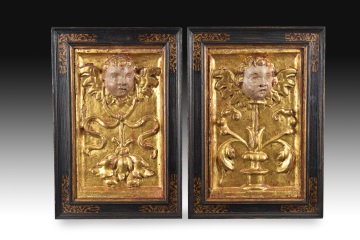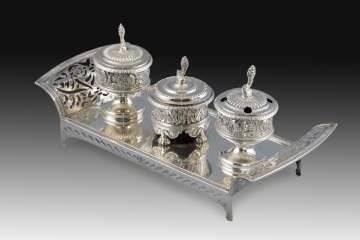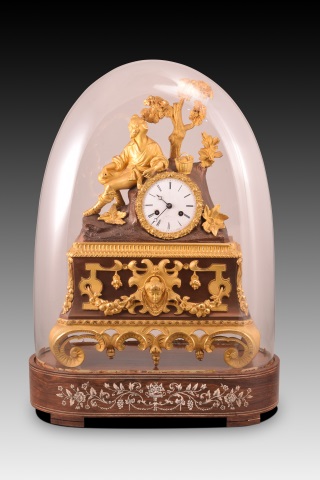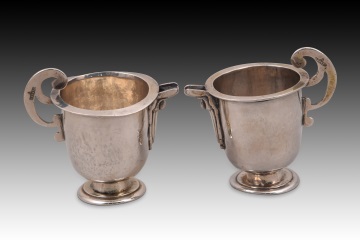
-
Dog-shaped knocker. Wrought iron. Spanish School, 15th century. Wrought iron knocker with a star-shaped striking piece featuring engraved decoration and a zoomorphic end (the typology, common in the Spanish Gothic school, is known as "dog-shaped"). This type of knocker was common in important residences, and similar examples are preserved in institutions such as the Provincial Ethnographic Museum of León or on the doors of houses such as those in Valdespino de Somoza.
· Size: 15x5x21 cms.
ANTIQUES
MISCELLANEUS;OTHER OBJECTS
Ref.: Z3687
-
Bedroom decoration. Carved and polychrome wood. Italian school, 19th century. Architectural decoration made of carved and polychrome wood, composed of a central mixed-linear arch and two trilobed side arches flanking it with two small steps below. The decoration based on vegetal scrolls, diamonds, rhombuses, capitals, etc. is inspired by Italian Renaissance models, adding variations that are common in the historicist interpretations of the 19th century.
· Size: 252x16x291 cms.
DECORATIVE ANTIQUES
FURNITURE
Ref.: Z3854
-
Contemporary table base. Carved and polychrome wood. Table base inspired by 19th century neoclassical French models that features a bust of a half-naked child holding a cushion on his head and with the lower half of his body transformed into a pillar decorated with plant and architectural elements reminiscent of the Rococo.
· Size: Alt. 65 cms.
N/D
Ref.: Z4709
-
Sideboard. Walnut wood carved in its colour. 19th century. Double-body sideboard with a decorated front made of carved walnut wood. The lower body has a decoration on both doors, enhanced by columns on the sides; a similar composition is found on the upper body, varying the decorative theme of the doors. In the centre, an empty space has been left with different wooden elements. Both the shape and the decoration of the piece recall antique Spanish furniture, of classicist inspiration.
· Size: 140x60x237 cms.
ANTIQUES
FURNITURE
Ref.: Z4912
-
Dressing table with mirror. Wood, glass, metal, stone. 19th century. Chest of drawers with four drawers at the front and a stone top with a front on the top with two more drawers, a mirror, and a series of architectural and vegetal carvings reminiscent of Elizabethan architecture. The carvings, centered on the sides of the lower part and on the top and sides of the mirror, show neoclassical influences.
· Size: 53x110x100 cms ALT ESPEJO 133 cms.
DECORATIVE ANTIQUES
FURNITURE
Ref.: Z4913
-
Mirror of Ferdinand VII. Carved and gilded wood, glass. Circa early 19th century. Rectangular mirror made of carved wood in its natural color, combined with decorations of strong classical influence of carved and gilded wood, reminiscent of bronze appliques that were common in French furniture, which inspired this piece.
· Size: 102x6x197 cms
ANTIQUES
FURNITURE
Ref.: Z5300
-
Folding mahogany side table in the George II style, USA (America), circa 1860. A tripod with animal claws gripping a ball serves as the base for the furniture's foot, adorned with a small fluted column and a vegetal bulb. The folding mechanism is located above this foot, and the top surface is round with a profile featuring curves flanked by straight sections. American furniture owes much to English design, as this example demonstrates: it follows the so-called George II style, named after the monarch during whose reign it was created (he was born in 1683 and died in 1760), and is based on models taken from Renaissance Roman architecture.
· Size: 78x78x72 cms.
ANTIQUES
FURNITURE
Ref.: Z5502
-
Convoy of silver cruets. Cordoba, Cristóbal Sánchez Soto (1755-1802), around the third third of the 18th century. With contrast and engraving marks. The current convoy retains a subtle Rococo influence in its lines, but also displays some Neoclassical decorative purity. The craftsman, Cristóbal Sánchez Soto, is well-known for important works such as a processional platform for the Virgin of Solitude and a tabernacle, both for the Brotherhood of the Nazarene in Córdoba, for example. The other two hallmarks that appear are those of the town (Córdoba) and the assayer, Juan de Luque y Leyva (1721-1779). Weight 400 gr. .
· Size: 20x11x21 cms.
ANTIQUES
MISCELLANEUS;SILVER
Ref.: Z6547
-
Frame. Carved and gilded wood. 18th century. Rectangular frame made of carved and gilded wood that combines a thin smooth band on the inside, with another carved band with a band and another on the outside, in which smooth areas are combined with delicate plant details (these in the same finish as the rest of the molding, highlighted on a striped background). Nowadays, the value and appreciation of frames is on the rise due to the search for them by museums and important institutions, with the aim of giving the works the frames they would have had originally. Hence, similar examples are found in some paintings by Vermeer, for example, or can be found in the Metropolitan Museum in New York, in the Louvre Museum, in the British Museum and in the Victoria & Albert in London, etc.
· Size: 75x6x58 cms. / 50x38 cms.
ANTIQUES
MISCELLANEUS;FRAMES
Ref.: ZE225
-

Pair of reliefs; grotesques or candelieri. Carved, polychrome and gilded wood. 16th century. Pair of reliefs made of hand-carved, gilded and polychrome wood, each showing a winged angel's head (or putti), placed on a vertical element that acts as an axis of symmetry for the composition of the relief. The rest of the motifs that complete the works are leaves with scrolls, floral or vegetal details, latticework, mouldings, all of clear classicist influence. The background does not present any decorative element, neither carved nor painted, thus leaving the spotlight to the aforementioned elements. This type of composition was very common in the Renaissance throughout Europe, when the “fashion” of grotesques spread from Italy. Compare, for example, the frieze reflected in an image of the work by Diego de Sagredo entitled “Medidas del Romano” (1526, Toledo); details of the Chapel of Santa Librada in the Cathedral of Sigüenza by Francisco de Baeza (around 1520); others from the façade of the Escuelas Mayores of the University of Salamanca; Main Altarpiece of the Collegiate Church of Torrijos (Toledo), commissioned in 1558 from Juan Correa de Vivar; etc. It should be noted that these decorative motifs will have a long tradition in Spanish art. It is quite possible that the present relief plaque was created to form part of an altar in a church although it is not decorated with a religious theme (note that the theme of “winged heads”, often called “putti”, also comes from Italy and is found in both civil and religious works).
· Size: 14x5x22 cms.
ANTIQUES
SCULPTURE
Ref.: ZE238
-
Reliefs with angel heads. Polychrome and gilded wood. Spanish school, 16th century. Pair of rectangular panels with a ring for hanging on the back, which feature two deep figurative reliefs on the front. On a gold background, two winged children's heads are shown, one looking to each side. Note the gold details on the feathers, with a somewhat heraldic arrangement and shape, and the pictorial treatment of the hair. This type of relief was very common in the Spanish school from the Renaissance onwards to decorate altars, reredos, etc. Weight: 600 grams.
· Size: 32x6x11 cms
ANTIQUES
SCULPTURE
Ref.: ZE371
-
Naveta. Silver in its colour. Salamanca, Spain, 1824-1850. With contrast marks and text. Silver vessel in its colour with a circular, stepped base decorated with ready mouldings, a turned axis or base with lines, and an elongated upper part, with a lid on one side and a protuberance on the other side of the piece (note the damage here). The hallmarks on the edge of the upper part (under the hinged lid) and on the foot place the production of this naveta in Salamanca, during the years of the faithful hallmark known as Bernabé Hidalgo (apparently documented in 1840, considered by some to be active in the 18th and 19th centuries; there is evidence of a Bernabé Sahagún Hidalgo working as a hallmark in Salamanca between 1824 and 1850). The other hallmark could not be identified. Also note the legend “Billaberde” located on the foot of the piece. Weight: 454 grams.
· Size: 16x10x18 cms.
ANTIQUES
MISCELLANEUS;SILVER
Ref.: ZE438
-
Motorized fire truck or sprayer. EC Flader of Jöhstadt, Germany, circa 1920. A horse-drawn motorized sprayer from the EC Flader company of Jöhstadt (the name is partially visible on the rectangular label on the front of the device). It features a folding compartment and space for machinery in the rear. It is driven by two spoked wheels and has a vertical bar for securing it to the ground when in use. This type of machine was used by firefighters, usually in cities. The present example is known to have been in use, for example, in 1925 in Wellsdorf.
· Size: 130x230x145 cms.
DECORATIVE ANTIQUES
MISCELLANEUS
Ref.: Z1009A
-
Motorized fire truck or sprayer. EC Flader of Jöhstadt, Germany, circa 1920. A motorized sprayer designed to be pulled by horses by the EC Flader firm of Jöhstadt, with a folding compartment and space for machinery in the rear, driven by two spoked wheels and equipped with a vertical bar for securing to the ground when in use. This type of machinery was used by firefighters, usually in cities, and the present example, if it is indicated, is known to have been in use in 1925 in Wellsdorf.
· Size: 340x142x125 cms.
DECORATIVE ANTIQUES
MISCELLANEUS
Ref.: Z1009C
-
Fire truck or irrigation pump. Renault, 20th century. A trailer or cart with a motor and two hose heads, hose, and other parts and mechanisms that would have been used for watering, spreading water, etc. The brand can be seen on the plate located on the front of the machine.
· Size: 260x130x135 cms.
DECORATIVE ANTIQUES
MISCELLANEUS
Ref.: Z1009D
-
Courtiers and Cage. Glazed porcelain. Johann Joachim model. Circa 1800 Glazed porcelain figure with a rock-like base and a pair of lovers dressed in 18th-century fashion, with the boy reaching out with his left hand toward a large birdcage. The piece is very similar to some figures titled "Lovers with Cages" made by Du Paquier (who opened a porcelain factory in Vienna in 1719) in 1737, examples of which are preserved in the Metropolitan Museum of Art in New York and the Indianapolis Museum of Art. Du Paquier, in turn, drew his inspiration from works done in Meissen by Johan Joachim Kaendler around 1736-1740 (varying in details such as replacing the German table with the Viennese table cage in some examples, or colors, for example). If we compare the present work with Du Paquier's works, we can see notable similarities in postures, elements, etc., but also important differences (colors, details, base of the figure, etc.).
· Size: 14x12x13 cms.
ANTIQUES
MISCELLANEUS;CERAMIC
Ref.: ZF0445
-
Historical compendium of the arquebusiers of Madrid… Soler, Isidro (fl. Ca. 1795). Madrid, 1795. Original, leather binding. 86 pages. Perfect condition. “Historical compendium of the arquebusiers of Madrid from their origin to the present day, with two plates in which are engraved the marks and countermarks that they used in their works”, by Isidro Soler, arquebusier of the King Our Lord. Printing house of Pantaleón Aznar, 1795, Madrid. 86 p., 2 hr. of engraving. Full leather binding with gilt spines and decorated interveins; gilt edges, counter-edges and cuts; cover with embossed and gilt borders framing a royal superlibris with the Golden Fleece and closed crown.
· Size: 15,5x1,5x20,5 cms.
ANTIQUES
MISCELLANEUS;OTHER OBJECTS
Ref.: ZF0568
-
Frame. Gilded and polychrome wood. 17th century. It presents loss in the lower left area. Frame made of carved wood, gilded and polychromed in certain areas, with decoration based on bands (alternating plain ones with others with vegetal and architectural elements) and a relief at the top with vegetal and architectural motifs, combining polychromy with gilding in this area and below. Note the similarity between the decoration and lines of this piece and certain Spanish Baroque altarpieces of the 17th century.
· Size: 105x16,5x101,5 / int 81x57 cms.
ANTIQUES
MISCELLANEUS;FRAMES
Ref.: ZF0631
-
Sold

Writing case with three inkwells. Silver. Martínez Royal Silversmiths Factory, Madrid, 1845. With contrast marks. Silver writing table in its colour, composed of a rectangular tray with raised, openwork sides and openwork decoration on the longer sides (downwards), and three containers (two cup-shaped) topped with figurative elements. Both the decoration of the elements and their lines show a clear influence of Neoclassical models based on Antiquity. The hallmarks present link the piece to the city of Madrid (Spain), also adding the date and the silversmith. The Royal Martínez Silver Factory was founded in 1778, and represented the introduction in Spain of the industrial manufacturing method in the field of silver work and of neoclassical aesthetics in Spanish silverwork. It was also one of the most important silver centres in the history of Spain, and was characterised by the originality of its designs and the perfect finish of its pieces. Compare this piece, for example, with the mancerina with a tray and acanthus leaves from the same factory dated 1834 in the Museum of History of Madrid, and with other works preserved in private collections. Weight: 490 grams.
· Size: 23x11x10 cms
ANTIQUES
MISCELLANEUS;SILVER
Ref.: ZF0680
-
Floor lamp. Glass, metal. circa mid-20th century. Floor lamp, made of white glass and metal with a copper finish, featuring a composition on the base alternating glass clusters with small metal discs and ending in two horizontal points of light and a metal cup. Its shape and decoration are reminiscent of works from Murano (Italy) from the mid-20th century.
· Size: 55x55x171 cms s/pantalla: 35x35x170 cms
DECORATIVE ANTIQUES
FURNITURE
Ref.: ZF0908
-
Sold

Table clock with lantern. Bronze, wood, glass. 19th century. Table clock with a base enhanced by a series of gilt bronzes in a distinct Renaissance and Classicist style. It features a rocky top (on which the white dial with Roman numerals is located), on which a young man leans, looking up at a vine with bunches of grapes. The clock is protected by a glass lantern with a wooden base decorated with light-colored marquetry, depicting floral and vegetal themes.
· Size: 40x20x27 cms. reloj 33x13x45 cms.
ANTIQUES
MISCELLANEUS;CLOCKS
Ref.: ZF0941
-

Pair of spouted jugs. Silver. BENITO GOMEZ, Antonio (1775-1835). Segovia, Spain, 1801-1835. With contrast marks. Pair of small jugs with a circular base with mouldings, a low conical foot and a tubular body ending in a hemisphere at the bottom and with a flat moulding at the top; the handle, in double C, has a simple volute or branch that rests towards the mouth of the piece; the spout shows simple decoration. Typologically, the present pair is linked to a type of spouted jug that, with variations, was common in Spanish domestic silverware from the first half of the 17th century until the beginning of the 18th century, and was also found after this date. As usual, the civil model was quickly assimilated by religious silverware, especially for use in liturgical cruets. Antonio Benito Gómez (1775-1835) was a silversmith who worked in Segovia from at least 1801 until his death, and also a silversmith who worked between 1824 and 1828 and between 1831 and 1835. Son of the silversmith Juan de la Cruz Benito, several of his works have been preserved: a baptismal shell and a small rostrillo for the church of Vera Cruz in Zamarramala, a hyssop found in the church of Nuestra Señora de los Dolores in La Granja de San Ildefonso (Segovia), etc. Stylistically, most of his known work is clearly Rococo in style, although some Neoclassical pieces stand out.
· Size: 8,5x5,5x8 cms.
ANTIQUES
MISCELLANEUS;SILVER
Ref.: ZF0984
-
Art Nouveau ceiling lamp. Metal, glass. Circa 1900. Gold metal ceiling lamp with several points of light hidden by white translucent glass shades decorated with geometric elements. The stems, leaves and shapes it presents frame it within Modernism or Art Nouveau, a style highly appreciated in Europe around 1900.
· Size: 61x61x67 cms.
ANTIQUES
FURNITURE
Ref.: ZF1291
-
Mustard and spice jars. Silver, "regent plate", glass. 20th century. Incomplete. With contrast marks. A collection of sixteen pieces (tubular salt shaker, three spice racks, mustard jars) bearing hallmarks. Some are English (from Birmingham, by AL Davenport Ltd, established around 1927, GJ Myatt & Co. Ltd., Arthur Willmore Pennington –established 1901–, S. Blanckensee & Son Ltd.; Goldsmiths' & Silversmiths' Company –established in London in 1880–; etc.), while others combine glass (both clear and transparent) with metal elements. Stylistically, they are inspired by traditional designs. Weight: 900 grams
· Size: 7x5,5x6,5 cms
ANTIQUES
MISCELLANEUS;SILVER
Ref.: ZF1374